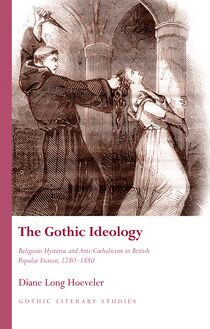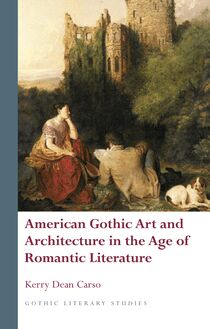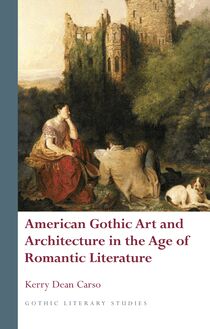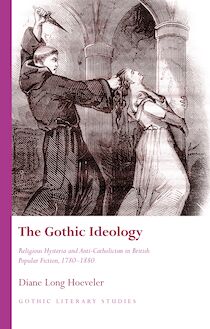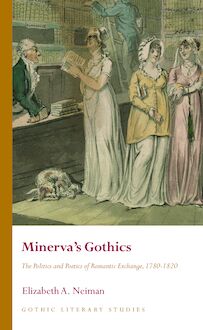-
 Univers
Univers
-
 Ebooks
Ebooks
-
 Livres audio
Livres audio
-
 Presse
Presse
-
 Podcasts
Podcasts
-
 BD
BD
-
 Documents
Documents
-
- Cours
- Révisions
- Ressources pédagogiques
- Sciences de l’éducation
- Manuels scolaires
- Langues
- Travaux de classe
- Annales de BEP
- Etudes supérieures
- Maternelle et primaire
- Fiches de lecture
- Orientation scolaire
- Méthodologie
- Corrigés de devoir
- Annales d’examens et concours
- Annales du bac
- Annales du brevet
- Rapports de stage
La lecture à portée de main
Vous pourrez modifier la taille du texte de cet ouvrage
Découvre YouScribe en t'inscrivant gratuitement
Je m'inscrisDécouvre YouScribe en t'inscrivant gratuitement
Je m'inscrisEn savoir plus
Vous pourrez modifier la taille du texte de cet ouvrage
En savoir plus

Description
This volume provides readers with a comprehensive literary and historical basis for understanding servant characters and servant narratives in the early Gothic mode. Throughout the eighteenth and nineteenth centuries, servants were ‘othered’ figures whose voices had the potential to undermine socio-political and personal identity. This study recasts servant characters within the early Gothic mode as ‘narrators’ who verbally or non-verbally perform dialogue, moral insights and folkloric or gossip-based stories. Examining the development of servant narrative within the early Gothic mode, Servants and the Gothic outlines the socio-historical and literary influences which defined the servant voice during the eighteenth century, as well as identifying and expanding upon the ways in which servant narratives contributed to each author’s unique goals. It redefines servant narratives as a Gothic ‘performance’, a self-conscious self-examination of the ways in which a Gothic narrative impacts literary, social and personal identity.
Introduction: Domestic invasion: A portrait of the Gothic servant narrator
Chapter One: Servant narrative and ‘new romance’
Chapter Two: Gothic Servants and socio-political identity
Chapter Three: Gothic spectacle and the ‘performing’ servant
Chapter Four: Redefining Gothic servants
Conclusion Mastering the Gothic servant narrative
Notes
Bibliography
Sujets
Informations
| Publié par | University of Wales Press |
| Date de parution | 14 décembre 2018 |
| Nombre de lectures | 0 |
| EAN13 | 9781786833419 |
| Langue | English |
| Poids de l'ouvrage | 1 Mo |
Informations légales : prix de location à la page 0,3450€. Cette information est donnée uniquement à titre indicatif conformément à la législation en vigueur.
Extrait
SERVANTS AND THE GOTHIC, 1764–1831
SERIES PREFACE
Gothic Literary Studies is dedicated to publishing groundbreaking scholarship on Gothic in literature and film. The Gothic, which has been subjected to a variety of critical and theoretical approaches, is a form which plays an important role in our understanding of literary, intellectual and cultural histories. The series seeks to promote challenging and innovative approaches to Gothic which question any aspect of the Gothic tradition or perceived critical orthodoxy. Volumes in the series explore how issues such as gender, religion, nation and sexuality have shaped our view of the Gothic tradition. Both academically rigorous and informed by the latest developments in critical theory, the series provides an important focus for scholarly developments in Gothic studies, literary studies, cultural studies and critical theory. The series will be of interest to students of all levels and to scholars and teachers of the Gothic and literary and cultural histories.
SERIES EDITORS
Andrew Smith, University of Sheffield
Benjamin F. Fisher, University of Mississippi
EDITORIAL BOARD
Kent Ljungquist, Worcester Polytechnic Institute Massachusetts
Richard Fusco, St Joseph’s University, Philadelphia
David Punter, University of Bristol
Chris Baldick, University of London
Angela Wright, University of Sheffield
Jerrold E. Hogle, University of Arizona
Servants and the Gothic, 1764–1831
A half-told tale
Kathleen Hudson
© Kathleen Hudson, 2019
All rights reserved. No part of this book may be reproduced in any material form (including photocopying or storing it in any medium by electronic means and whether or not transiently or incidentally to some other use of this publication) without the written permission of the copyright owner except in accordance with the provisions of the Copyright, Designs and Patents Act. Applications for the copyright owner’s written permission to reproduce any part of this publication should be addressed to the University of Wales Press, University Registry, King Edward VII Avenue, Cardiff, CF10 3NS.
www.uwp.co.uk
British Library Cataloguing-in-Publication Data
A catalogue record for this book is available from the British Library.
ISBN 978-1-78683-339-6
eISBN 978-1-78683-341-9
The right of Kathleen Hudson to be identified as author of this work has been asserted by her in accordance with sections 77 and 79 of the Copyright, Designs and Patents Act 1988.
The publisher has no responsibility for the persistence or accuracy of URLs for any external or third-party internet websites referred to in this book, and does not guarantee that any content on such websites is, or will remain, accurate or appropriate.
Cover image: William Hogarth, ‘Ensnared by a procuress’ from A Harlot’s Progress (1732), engraving. Mary Evans Picture Library.
For Mom and Dad
C ONTENTS
Acknowledgements
Introduction: Domestic Invasion: A Portrait of the Gothic Servant Narrator
1 Servant Narrative and ‘new romance’
2 Gothic Servants and Sociopolitical Identity
3 Gothic Spectacle and the Performing Servant
4 Redefining Gothic Servants
Conclusion: Mastering the Gothic Servant Narrative
Notes
Bibliography
A CKNOWLEDGEMENTS
I would like to thank Professor Angela Wright and Professor Joe Bray for supervising my original research on this topic while I was a postgraduate the University of Sheffield. I would also like to thank the English Department and the University of Sheffield for accommodating my work and for providing me with the resources needed to complete my first drafts of this manuscript.
Special thanks to Professor Andrew Smith for encouraging the original submission of this work to University of Wales Press, and for his continued guidance and support throughout the writing and publication process.
Thanks to the Sheffield Gothic group for being an amazingly supportive community and for providing everything from reading recommendations to editorial input to moral support.
Thank you Jo, Sarah, Darren, Tom and Ami for your extraordinary friendship.
And finally, but most importantly, thank you to Mom, Dad, Mike and Sam for giving me the courage and drive, not to mention the millions of smaller but no less important moments of love, needed to undertake this project in the first place and to see it through to its completion.
Introduction
Domestic Invasion: A Portrait of the Gothic Servant Narrator
Was Ever such a Blockhead seen!
To choose a servant for his Heroine!
Henry and Anna Giffard, Pamela. A comedy (1741) 1
Today, servants who go from house to house, indifferent to the masters whom they serve, can meet an employer they just left without feeling any sort of emotion. They assemble only to exchange the secrets they have unearthed: they are spies, and being well paid, well dressed, and well fed, but despised, they resent us, and have become our greatest enemies.
Louis-Sébastien Mercier, Le Tableau de Paris (1781) 2
Had I, for example, announced in my frontispiece, ‘Waverley, a Tale of other Days’, must not every novel reader have anticipated a castle scarce less than that of Udolpho, of which the eastern wing had long been uninhabited, and the keys either lost, or consigned to the care of some aged butler or housekeeper, whose trembling steps, about the middle of the second volume, were doomed to guide the hero, or heroine, to the ruinous precincts?
Sir Walter Scott, Waverley (1814) 3
George Colman the Younger, in his satirical poem ‘My Night-gown and Slippers’ (1797), was suggestively accurate in his assertion that ‘A novel, now … is nothing more / Than an old castle and a creaking door.’ 4 Early Gothic texts are in many ways the literary equivalent of the quintessential haunted castle found in such works. Characters and readers alike explore the abandoned hallways and winding staircases of the tale’s emotional, psychological and material machinery, raising forgotten spectres and exposing hidden crimes before finally escaping from, or succumbing to, the landscape in which they find themselves. Manfred and Isabella’s wanderings through Otranto castle or Emily St Aubert’s explorations of Udolpho parallel the reader’s own negotiations of recurring Gothic devices, ultimately illuminating the characters’ secret selves and the broader impact of a complex historical and spiritual inheritance. The popular conception of the Gothic as a mode which brings the ‘other’ into the home and which makes the home itself something terribly other remains a deeply ingrained element of not only specific stories but also of the Gothic’s broader narrative strategies. Yet how is one to navigate such an unstable domestic space? Who, to echo Sir Walter Scott’s Waverley , is ‘doomed to guide the hero, or heroine, to the ruinous precincts’? 5 And, perhaps most crucially, how is such a journey to end – are the ‘trembling steps’ merely a physical progress, or does some even more profound internal development take place within this engagement? 6
Personal and social narratives moderate processes of self-fashioning and the ‘performance’ of both public and private versions of the self. As Barbara Hardy and other theorists have established: ‘we dream in narrative, daydream in narrative, remember, anticipate, hope, despair, believe, doubt, plan, revise, criticize, gossip, learn, hate and love by narrative.’ 7 Self-creation via narrative is in turn expressed in performative acts, an ongoing process of self-interpretation through which, as Judith Butler argues in Gender Trouble (1990), ‘reality is fabricated as an interior essence’ which is itself ‘an effect and function of a decidedly public and social discourse, the public regulation of fantasy through the surface politics of the body’. 8 Within this attempt to formulate and negotiate both personal and sociopolitical identity through verbal and nonverbal performance, no figure redefines the strategies of Gothic narrative quite like the servant character in early Gothic novels, chapbooks and theatrical adaptations. Even in the contested Gothic space, heroines, villains, lovers and parental figures respond in predictable ways to a variety of situational realities. Servants do as well, yet unlike other characters their role is determined as much by their violations of hegemonic identity as their functionality within established cultural and political structures. Anyone who has read an eighteenth- or nineteenth-century Gothic text will likely recall the presence of peripheral working-class figures whose verbal interjections interrupt or otherwise impact upon the larger plot. Typically, these characters participate in an exchange of dialogue with their employers, suggest a significant moral viewpoint, or perform a gossip-heavy anecdote or folkloric fireside tale, illuminating important plot points and providing insight into the emotional and moral states of other characters. Such interjections initially frustrate the protagonists and usually the reader as well, expanding simple explanations into tedious, and often bathetic, narratives.
The speaking and acting servant’s jarring presence arguably suggests a lack of sophistication in the earliest works of a literary mode that was still developing into what Horace Walpole described as ‘a new species of romance’. 9 After all, the servant’s practical function within eighteenth-century social and economic structures immediately encloses them within a highly specific and ostensibly marginal role, one which arguably defines and limits the scope of their narratives. Occupying one of the lowest rungs on the social ladder, servants maintained the domestic spaces of others without inhabiting such spaces fully as individuals. Rather, they were widely considered a highly problematic part of everyday life, an ‘othered’ entity whose personal knowledge could potentially compromise the entire household. Jenny Davidson points to the prevalence of the so-called ‘servant problem’ in literary
-
 Univers
Univers
-
 Ebooks
Ebooks
-
 Livres audio
Livres audio
-
 Presse
Presse
-
 Podcasts
Podcasts
-
 BD
BD
-
 Documents
Documents
-
Jeunesse
-
Littérature
-
Ressources professionnelles
-
Santé et bien-être
-
Savoirs
-
Education
-
Loisirs et hobbies
-
Art, musique et cinéma
-
Actualité et débat de société
-
Jeunesse
-
Littérature
-
Ressources professionnelles
-
Santé et bien-être
-
Savoirs
-
Education
-
Loisirs et hobbies
-
Art, musique et cinéma
-
Actualité et débat de société
-
Actualités
-
Lifestyle
-
Presse jeunesse
-
Presse professionnelle
-
Pratique
-
Presse sportive
-
Presse internationale
-
Culture & Médias
-
Action et Aventures
-
Science-fiction et Fantasy
-
Société
-
Jeunesse
-
Littérature
-
Ressources professionnelles
-
Santé et bien-être
-
Savoirs
-
Education
-
Loisirs et hobbies
-
Art, musique et cinéma
-
Actualité et débat de société
- Cours
- Révisions
- Ressources pédagogiques
- Sciences de l’éducation
- Manuels scolaires
- Langues
- Travaux de classe
- Annales de BEP
- Etudes supérieures
- Maternelle et primaire
- Fiches de lecture
- Orientation scolaire
- Méthodologie
- Corrigés de devoir
- Annales d’examens et concours
- Annales du bac
- Annales du brevet
- Rapports de stage


